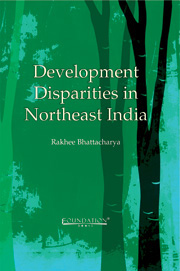Book contents
- Frontmatter
- Contents
- Preface
- List of Figures
- List of Tables
- 1 Challenges of Disparity in the Northeast
- 2 Dimensions of Disparity in the Northeast
- 3 Facets of Government Finance in the Northeast
- 4 Economy of Insurgency in the Northeast
- 5 Energy Interplay in the Northeast
- 6 Development Initiatives in the Northeast
- Index
3 - Facets of Government Finance in the Northeast
Published online by Cambridge University Press: 05 June 2012
- Frontmatter
- Contents
- Preface
- List of Figures
- List of Tables
- 1 Challenges of Disparity in the Northeast
- 2 Dimensions of Disparity in the Northeast
- 3 Facets of Government Finance in the Northeast
- 4 Economy of Insurgency in the Northeast
- 5 Energy Interplay in the Northeast
- 6 Development Initiatives in the Northeast
- Index
Summary
Growth and Government: Relationship in Northeast India
Perpetual growth retardation as seen in Chapter 2 has kept Northeast India outside the mainstream economy of India. Disparity across Indian States has widened and this cluster of states remains at the periphery of the country's economy. To understand the reasons for this, one needs to probe into the role of those sectors whose effective functioning has been crucial to the economy of these states. One such is the government sector. This chapter attempts to examine the role of the government and its financial arrangements, and its relationship with economic activities in Northeast India since Independence. Barro and Sala-i-Martin feel that the government can affect the economic growth rates in a number of ways. The volume of consumption, spending, level of taxation, distortion of international trade and political instability, are the negative influences of governmental intervention. Positive influences include maintaining and enhancing existing institutions, developing financial institutions and spending on public infrastructure. Government policy and economic growth are inextricably linked, and government functioning and policy do affect the growth of an economic entity. Therefore, the relationship between government policies and growth becomes a priority area for economic research, and the present chapter is a case study on the role of government finances in the Northeast region's economic development.
It is time to find out the reasons why the economic performance of the region has remained so poor.
- Type
- Chapter
- Information
- Development Disparities in Northeast India , pp. 56 - 90Publisher: Foundation BooksPrint publication year: 2011



